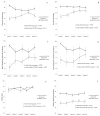Long-Term Impacts of COVID-19 Pneumonia on Quality of Life: A Single Institutional Pilot Study
- PMID: 37444797
- PMCID: PMC10341595
- DOI: 10.3390/healthcare11131963
Long-Term Impacts of COVID-19 Pneumonia on Quality of Life: A Single Institutional Pilot Study
Abstract
Many studies have demonstrated poor quality of life (QoL) at 3, 6, 12, and 24 months after coronavirus disease 2019 (COVID-19). However, these studies were limited due to cross-sectional design, a longer gap between visits, and lack of controls for comparison. Therefore, the aim of our prospective study was to assess the impact of COVID-19 pneumonia on QoL in both physical and mental health. A prospective study was conducted on adult patients with COVID-19 pneumonia. We used the 36-Item Short Form Health Survey (SF-36) and Euro Quality of Life-5 Dimensions-5 Levels (EQ-5D-5L), EQ visual analogue scale (EQ-VAS), and Hospital Anxiety and Depression Scale to collect data at months, 1, 3, 6, 9, and 12. Thirty-eight patients with COVID-19 pneumonia and twenty-five healthy subjects were completely followed up on all visits. All domains of SF-36, except bodily pain and EQ-5D-5L of the patients, were lower than controls. There was an improvement of EQ-VAS and SF-36 including physical functioning, social functioning, and role limitation (physical problems) domains throughout study period in the COVID-19 pneumonia group. Adult patients who recovered from COVID-19 pneumonia had lower QoL which improved over the one-year follow-up period.
Keywords: COVID-19 pneumonia; anxiety; depression; long-term follow-up; quality of life.
Conflict of interest statement
The authors have no potential conflict of interest.
Figures





References
-
- World Health Organization COVID-19 Weekly Epidemiological Update. [(accessed on 26 February 2023)]. Edition 50 Published 27 July 2021. Available online: https://www.who.int/emergencies/diseases/novel-coronavirus-2019?
-
- Bostancı Ö., Karaduman E., Çolak Y., Yılmaz A.K., Kabadayı M., Bilgiç S. Respiratory muscle strength and pulmonary function in unvaccinated athletes before and after COVID-19 infection: A prospective cohort study. Respir. Physiol. Neurobiol. 2023;308:103983. doi: 10.1016/j.resp.2022.103983. - DOI - PMC - PubMed
-
- World Health Organization A Clinical Case Definition of Post COVID-19 Condition by a Delphi Consensus. Oct 6, 2021. [(accessed on 26 February 2023)]. Available online: https://apps.who.int/iris/handle/10665/345824.
Grants and funding
LinkOut - more resources
Full Text Sources
Miscellaneous

